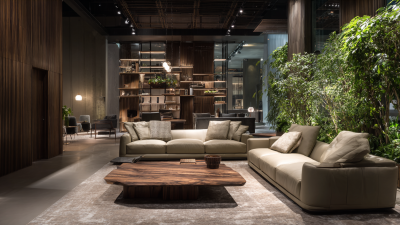7 Essential Tips for Choosing High Quality Furniture That Lasts
When investing in home decor, the choice of "High Quality Furniture" is paramount, not only for aesthetic appeal but also for durability and longevity. According to a report by the American Home Furnishings Alliance, nearly 70% of consumers express a strong preference for furniture that can withstand daily wear and tear, emphasizing the significance of quality craftsmanship. Moreover, a study conducted by Statista shows that the furniture market is projected to reach a value of over $700 billion by 2027, highlighting an increasing consumer focus on investing in sustainable and durable products. The right furniture not only enhances the beauty of your living space but also represents a long-term investment in your home’s value. Therefore, understanding how to select high-quality pieces is essential for anyone looking to create a lasting and functional interior design.

Identify Durable Materials: 5 Key Characteristics of Long-Lasting Furniture Components
When selecting high-quality furniture, understanding the materials used in its construction is vital. Several studies, including a report from the Furniture Industry Research Association, highlight that the longevity of furniture heavily relies on specific characteristics of its components. For instance, hardwoods such as oak and maple are commonly noted for their durability, exhibiting a density that can withstand daily wear and tear. A piece made from solid wood can last up to 25 years or more with proper care, as opposed to softer woods which may only last a decade.
Additionally, attention should be paid to the quality of upholstery materials. According to the American Home Furnishings Alliance, fabrics treated with stain and fade resistance can significantly enhance a piece’s lifespan. High-performance synthetic fibers, like polyester and nylon, have become increasingly popular due to their ability to resist discoloration and abrasion over time. The manufacturing methods also play a critical role; pieces that showcase high-quality joinery and reinforcement techniques are less likely to develop structural issues, further contributing to the furniture's durability.
Understand Craftsmanship: How Joinery Methods Impact Furniture Longevity
When choosing high-quality furniture, understanding craftsmanship is crucial, particularly the joinery methods used in its construction. Joinery refers to the techniques employed to connect different pieces of wood together, and it significantly influences the durability and longevity of furniture. Traditional methods such as dovetail and mortise-and-tenon joints are renowned for their strength and stability. These techniques create a solid bond that can withstand the stresses of everyday use, ensuring that your furniture remains intact for years to come.
Conversely, modern manufacturing methods, such as using staples or glue, may compromise the furniture's structural integrity. While they can be less expensive and quicker to produce, these joints may loosen over time, leading to a shorter lifespan for the piece. When shopping for furniture, inspecting the joinery can provide insight into the quality of craftsmanship. Look for well-executed joints that demonstrate attention to detail, as this indicates a commitment to durability. Investing in furniture made with traditional joinery methods not only enhances its aesthetic appeal but also ensures you are choosing pieces that will stand the test of time.
Impact of Joinery Methods on Furniture Longevity
Evaluate Upholstery: The Best Fabric Choices for Wear Resistance and Comfort
When choosing high-quality furniture, evaluating upholstery is crucial, as the fabric can significantly impact both wear resistance and comfort. According to a report from the International Textile and Apparel Association, over 60% of consumers prioritize durability when selecting upholstered furniture. Fabrics such as microfiber, treated cotton, and leather are known for their resilience against daily use, making them excellent choices for high-traffic areas. Microfiber, for instance, is not only stain-resistant but also offers a soft touch, making it a favored option for families with children and pets.
Furthermore, understanding the fabric's durability rating can help in making informed decisions. The Martindale test, which measures the abrasion resistance of textiles, indicates that fabrics rated above 15,000 rubs are suitable for commercial use, suggesting they can withstand years of wear. Additionally, natural fibers like wool can provide both durability and comfort, as they are inherently resilient and add a luxurious feel to the furniture. By focusing on high-wear-resistant fabrics, consumers can ensure their furniture not only looks good but also stands the test of time.
7 Essential Tips for Choosing High Quality Furniture That Lasts
| Fabric Type | Wear Resistance Rating | Comfort Level | Maintenance Level |
|---|---|---|---|
| Leather | High | Very Comfortable | Low |
| Microfiber | Medium | Comfortable | Medium |
| Cotton | Low | Very Comfortable | High |
| Polyester | Medium | Comfortable | Medium |
| Canvas | Medium | Moderately Comfortable | Medium |
Assess Brand Reputation: 3 Metrics to Consider for Trusted Furniture Manufacturers
When selecting high-quality furniture, assessing brand reputation is critical. One effective way to evaluate furniture manufacturers is by considering their longevity in the market. According to recent statistics, brands that have maintained a strong presence for over 30 years often exhibit consistent quality and customer satisfaction. Additionally, a manufacturer's commitment to ethical production practices can significantly enhance its reputation. Research indicates that 73% of consumers are willing to pay more for products from brands that align with their values, which increasingly includes sustainability and fair labor practices.
Another important metric to consider is customer reviews and testimonials. Studies show that 84% of people trust online reviews as much as personal recommendations. Therefore, examining customer feedback across various platforms can provide insights into product reliability and service quality. Additionally, brands with high ratings in customer service often have lower return rates and higher overall satisfaction, indicating that they prioritize their customers’ needs, which is crucial when investing in lasting furniture. By focusing on these metrics, consumers can make informed choices that result in worthwhile purchases.

Consider Functionality: 4 Essential Features That Enhance Furniture Durability
When selecting high-quality furniture, functionality is key to enhancing durability. A report by the American Home Furnishings Alliance highlights that furniture engineered with multi-purpose features tends to have a longer lifespan. For instance, sofas that convert into beds maximize space while being versatile, providing utility that withstands everyday use. Similarly, tables with extendable functionality can accommodate various gatherings, ensuring they remain relevant as lifestyles change over time.
Another essential feature to consider is the material used in the furniture's construction. Research from the Sustainable Furnishings Council indicates that solid hardwoods, such as oak and maple, not only offer aesthetic appeal but also boast significant resilience against wear and tear. Additionally, furniture that incorporates high-quality upholstery like top-grain leather or durable synthetic fabrics can significantly improve longevity. These materials resist fading and damage, making them ideal for households with high traffic or pets. By prioritizing functionality and material quality, consumers can invest in pieces that truly stand the test of time.

Related Posts
-

What Defines High Quality Furniture: Key Characteristics to Consider
-

Challenges in Choosing Best Quality Furniture for Your Home
-

How to Select the Best Outdoor Home Collection for Your Global Sourcing Needs
-

Discover the Global Reach of Chinese Manufacturing Through the Best Home Catalogs
-

Top 10 Home and Furniture Manufacturers from China at the 137th Canton Fair
-

Discovering Home Decorations Trends at the 137th Canton Fair Successes and Opportunities

 Catalog
Catalog Replacement Cushions
Replacement Cushions New Jersey Catalog
New Jersey Catalog